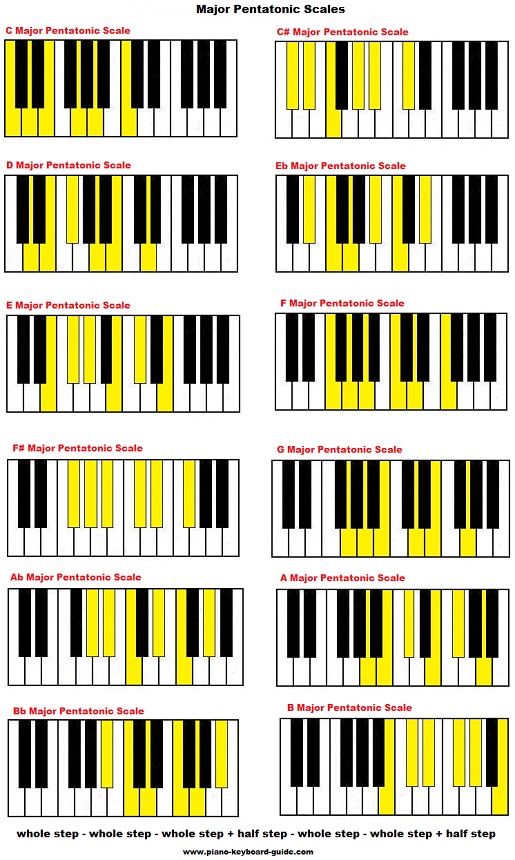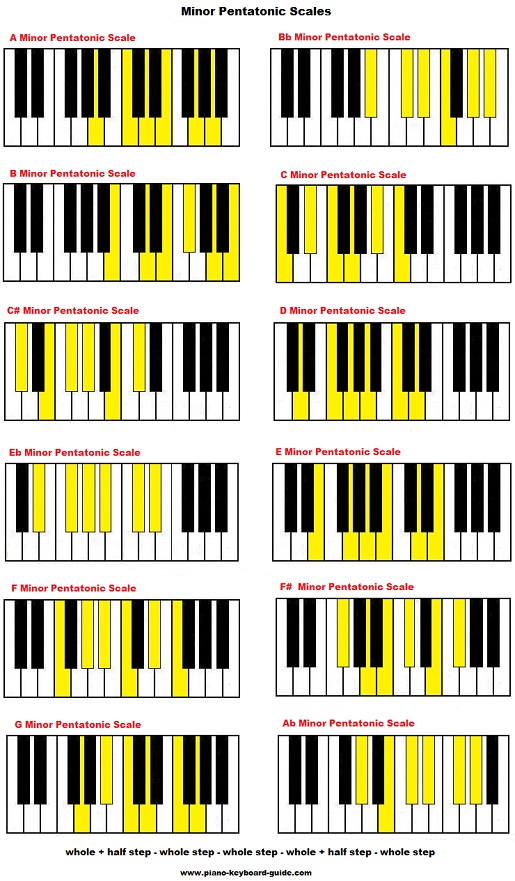Let’s learn how to form pentatonic scales on piano. This type of scale has five notes per octave unlike a heptatonic scale which has seven notes. Examples of heptatonic scales are the major scale and the minor scale. Unlike major and minor scales, the pentatonic has no semitones.
The word “pentatonic” comes from the Greek word pente which means five and tonic which means tone. This scale is often referred to as a five-tone scale or a five-note scale. It is believed to have been used way back in ancient times. The major pentatonic is the basic scale of the music of China and Mongolia.
My Best Recommendation: Click here for the BEST piano/keyboard course I’ve seen on the Internet.
There are various types of pentatonic scales. Firstly, let’s take a look at the major pentatonic. Later on we shall take a look at the minor pentatonic.
The major pentatonic consists of the 1st, 2nd, 3rd, 5th and 6th notes of a major scale. For instance, let’s take a look at the C major scale. The notes of the C major scale are C – D – E – F – G – A – B. The C major pentatonic would therefore be, the 1st note, C, the 2nd note, D, the third note, E, the 5th note, G, and the 6th note, A, or C – D – E – G – A.
If you play the black keys on your piano, you will hear that pentatonic sound. The black keys on your piano are pentatonic and they’re in the key of G flat and its relative minor, E flat minor.
Watch Part 1 Of This Lesson: How To Form Major Pentatonic Scales On Piano
One way of forming the pentatonic is to use the following formula after picking the starting note of the scale. The formula is W, W, W+H, W, W+H (whole step, whole step, whole step plus half step, whole step, whole step plus half step). You can also use the intervals, 1, 2, 3, 5, 6. In terms of semitones, it’s 2 – 2 – 3 – 2 – 3.
However, I think it’s much easier to remember to drop the 4th and 7th notes of the major scale, leaving you with the five notes of the pentatonic.
Let’s take a look at the major pentatonic scale in all 12 keys.
- C pentatonic: C, D, E, G, A, C
- C# pentatonic: C#, D#, F, G#, A#, C#
- Db pentatonic: Db, Eb, F, Ab, Bb, Db
- D pentatonic: D, E, F#, A, B, D
- Eb pentatonic: Eb, F, G, Bb, C, Eb
- E pentatonic: E, F#, G#, B, C#, E
- F pentatonic: F, G, A, C, D, F
- F# pentatonic: F#, G#, A#, C#, D#, F#
- Gb pentatonic: Gb, Ab, Bb, Db, Eb, Gb
- G pentatonic: G, A, B, D, E, G
- Ab pentatonic: Ab, Bb, C, Eb, F, Ab
- A pentatonic: A, B, C#, E, F#, A
- Bb pentatonic: Bb, C, D, F, G, Bb
- B pentatonic: B, C#, D#, F#, G#, B

The Minor Pentatonic Scale
The minor pentatonic scale consists of the same 5 notes of the major pentatonic. For example, the relative minor of C is A minor, and the notes which form C major pentatonic and A minor pentatonic are the same. The only difference is that the tonic (first note of the scale) of the minor pentatonic is 3 semitones (half steps) below the tonic of the major pentatonic. The notes for C major pentatonic are C – D – E – G – A, while A minor pentatonic is A – C – D – E – G. Clearly these are the same 5 notes except for the starting note or tonic. They are simply arranged differently.
Watch Part 2 Of This Lesson: How To Form Minor Pentatonic Scales On Piano
The minor pentatonic uses the 1st, minor 3rd, 4th, 5th and minor 7th notes of a major scale or 1st, 3rd, 4th, 5th and 7th of the natural minor scale. The formula for forming this scale is W+H, W, W, W+H, W (whole and a half step, whole step, whole step, whole and a half step, whole step). In terms of semitones, it’s 3 – 2 – 2 – 3 – 2.
Here’s a list of all twelve minor pentatonic scales:
- A minor pentatonic: A, C, D, E, G, A
- Bb minor pentatonic: Bb, Db, Eb, F, Ab, Bb
- B minor pentatonic: B, D, E, F#, A, B
- C minor pentatonic: C, Eb, F, G, Bb, C
- C# minor pentatonic: C#, E, F#, G#, B, C#
- D minor pentatonic: D, F, G, A, C, D
- Eb minor pentatonic: Eb, Gb, Ab, Bb, Db, Eb
- Em pentatonic: E, G, A, B, D, E
- F minor pentatonic: F, Ab, Bb, C, Eb, F
- F#m pentatonic: F#, A, B, C#, E, F#
- G minor pentatonic: G, Bb, C, D, F, G
- G# minor pentatonic: G#, B, C#, D#, F#, G#

When you play the minor pentatonic scale, you may notice that it sounds a bit bluesy. This is because this scale is really the blues scale with one note missing. For example, in an A minor blues scale, the added note would be D sharp.
The pentatonic scale is a great scale for improvising and soloing. You just need to know the right notes for each key. Any note you hit in this scale, usually sounds right when soloing. Keep practicing these scales. They are great “tools” to have and will surely help you sound better.
My number one recommendation on this site for learning how to play the piano is Piano For All. Learn about Piano For All here.
Return to main piano scales page.